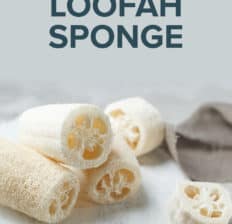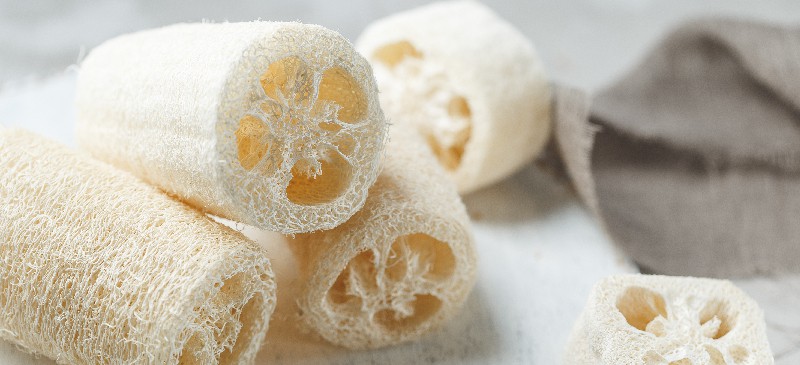


A loofah sponge probably conjures up images of rough, exfoliating fibers for bath time, but there’s really so much more to this vegetable. (That’s right, it’s a veggie.)
“Loofah,” also known as loofa, luffa or sponge gourd, is something most folks buy in the beauty aisle, but you can actually grow it at home.
Believe it or note, a loofah sponge comes from a vining plant in the gourd family. (It’s more formally known as Cucurbitaceae, which also includes summer and winter squash, pumpkin, watermelon, cucumber, melon and hard-shelled gourds.)
Loofahs, or luffas, can be grown from seeds as annuals in the United States, though they need a long season to mature into long-wearing sponges.
Buying a Loofah
Lots of stores sell natural loofah sponges in either their original cylindrical shape or shaped into scouring pads or body mitts. Whatever shape you choose, here’s what to look for:
- The fibers should give slightly when you squeeze them. When dry, loofah fiber is pretty stiff, but it should not crack.
- Avoid any packages full of broken fibers.
- If you’re lucky, your local farmers market may sell locally grown, organic, unbleached loofah sponges. These appear more of a light tan hue compared to the pale tan of bleached, commercial sponges.
- Reject any that have black patches and/or smell musty. They could trigger black mold symptoms.
- The fiber is easy to cut, so you can buy big ones and divide them into multiple scrubbers, based on what you want to use them for.
How to Use
Never used a loofah sponge? No worries.
Here’s how to work one into your hygiene and cleaning routines. (Just be sure to use separate ones for cleaning versus bathing.)
- Wet your loofah sponge with warm water to soften it, add a little bit of soap or the natural cleaning product of your choice, and exfoliate or scrub away, using small, circular motions. (Gentle pressure is enough to clear away dead skin cells.)
- Avoid extra tender skin and anywhere that’s uncomfortable.
- A nice loofah sponge may just be the perfect way to get the most out of a healthy commercial or homemade body wash or goat milk soap.
- If you make your own soap, you can put slices of clean, dry loofah sponge in your soap molds when you pour it. This creates attractive and useful soaps with built-in scrubbers.
Health Benefits and Environmental Perks
The tough, rounded fibers that make up a loofah sponge are perfect for deeply exfoliating your skin without damaging it. Include exfoliation in your natural skin care routine to create fresher, smoother and younger-looking skin.
Using a loofah sponge to gently exfoliate also:
- Removes built-up oils and dirt particles clogging your pores, allowing them to contract and look smaller
- Helps reduce breakouts — use a home remedy for acne
- Removes dead skin cells, which can make your skin look patchy and your makeup cake up, accentuating wrinkles
- Opens the skin up so it can absorb other skin care products faster and more completely
Emerging research suggests loofah could serve as a natural, more affordable material for wound care, too. Dried loofah even served as a skin substitute in an animal study, helping the test subjects heal during wound care.
Vegan and Plastic-Free
If scrubbing with something that was once a live animal (a natural sea sponge) creeps you out, loofah sponges could be your new all-natural, renewable sponge. Clean it, and toss it into your DIY compost pile when it’s worn out!
Loofah Sponge Safety
Rinse your sponge with clear water after every use, squeeze it as dry as possible and hang it to dry. Don’t keep it in the shower to dry, as moist conditions will likely promote bacteria growth.
Like any other sponge or washcloth, the longer it stays moist, the more likely assorted bacteria and fungi are to set up shop and raise a (large) family.
If you’ve been scrubbing your skin with your loofah sponge, you’re also adding trapped skin cells to the mix, giving the unwanted critters breakfast in bed, so to speak. You wouldn’t keep using a washcloth for months without tossing it in the washing machine periodically, and you shouldn’t do it with a natural loofah sponge either.
Once or twice a week, toss your sponge in the dishwasher on high heat for disinfections, or soak it in a diluted pure essential oils solution for five minutes, rinse well and hang it up to dry.


If you can hang it outside in the sunshine, that’s the best thing, as ultraviolet light is a very effective germ killer. If your loofah gets moldy-looking or musty-smelling, it’s time to toss it in the compost and start using a new one.
Most people plan on replacing one they use for exfoliating every three or four weeks. If it still looks and smells good at that point, you can always downgrade it to scrubbing the floor or the car, but don’t play Russian roulette with your skin’s health.
How to Grow Your Own Loofah Sponge
One of the best things about loofah sponges is you can grow your own. For the price one sponge, you can get a packet of seeds and grow a year’s supply if you have a garden with a sunny trellis or even a big planter.
Choosing Seeds
Loofahs are grown from seeds, so that’s what you need to get started. Two closely related gourds, Luffa aegyptiaca (commonly known as angled luffa, ridged luffa, Chinese okra or vegetable gourd) and L. acutangula, also sometimes labeled L. cylindrica (commonly known as smooth luffa, Egyptian luffa or dishrag gourd), are both sold as loofah.
READ RELATED: Rice Water for Hair & Skin: Does It Really Work?
When you buy a packet of “luffa” seed, it may not specify which you are getting. The two kinds are used pretty much interchangeably, so you don’t need to sweat the details.
Both are vigorous — as in at least 20 to 30 feet long — annual vines with showy yellow flowers.
How the fruit looks depends a bit on the type you plant. Angled luffa fruit have lengthwise ridges separated by deep groves. Smooth luffa fruit only have shallow creases running the length of the fruit.
Depending on the cultivar, fruit can be anywhere from eight inches to 24 inches long at maturity. If you have a choice, the smooth luffa is a better shape for sponges.
Planting Loofah Seeds
A luffa seed can take up to 150 or even 200 warm days to sprout, grow into a vine, flower and produce a ready-to-harvest sponge, so most gardeners in zones 6 or lower start luffa seeds indoors in six-inch pots about four to six weeks before the last probable spring frost. Gardeners in higher zones can plant seeds directly in the soil or an outdoor container once the weather is warm in late spring.
The soil – not the air — temperature needs to be at least 70 degrees Fahrenheit for good germination. Don’t jump the gun, or the seeds will rot rather than grow.
What Loofah Plants Need to Grow
- Luffa vines need full sun, lots of room to ramble (or a large trellis to grow up … a garden shed they can climb over works)
- Rich soil
- A consistent supply of water, but not soggy, waterlogged soil
- Compost (beware of human sewage sludge in compost)
Growing Tips
- Germination can take up to 14 days, so patience is a must
- Before planting, soak seeds overnight in a glass of water to speed germination
- Plant three or four seeds a few inches apart in a group, pushing them ¾-inch deep into the soil
- Space groups three to six feet apart
- Once the plants are a foot tall, cut off less vigorous seedlings at ground level, leaving just the strongest one or two per group to grow
Caring for Loofah Vines
- Keep the weeds under control by pulling them or covering the area with organic mulch.
- Water the plants deeply if there is no rain for a few days or if the leaves wilt.
- Once the flowers start to appear, you may notice that some have tiny green gourds attached to them, and some don’t. This is normal: Gourds have male and female flowers. The female ones have tiny gourds that will develop if the flower is pollinated. The male ones exist only to create pollen and die.
- If you have flowers with tiny gourds, but the gourds just shrivel up after the flower closes, you may not have enough bees or wild pollinators working your vine. In that case, you can play bee by plucking a male flower (no tiny gourd under it) that just opened and rubbing its dusty, pollen center against the sticky protrusion inside the center of any female flowers that opened that day.
Harvesting Loofah Sponges
If sponges are your aim, you’re going to leave the gourds on the vine all season until the green skin fades to yellow. After that, they brown and start to dry out.
Ripening gourds lose weight, the skin gets dry and separated from the insides, and they may even rattle when you shake them. The longer a mature luffa can stay on the vine, the more fibers will develop and the tougher those fibers will be.
Gourds harvested too early will have thin, fragile fibers that will just break and crumble when you try to peel and use them.
Once a luffa gourd is dry and the skin pops or cracks when you squeeze it, you can pick it and peel it immediately or store it in a dry place to do later.
If frost threatens, pick the most mature gourds, and peel them immediately. Crack and peel off as much of the skin as possible, and shake out the seeds. (If the seeds are plump and the gourd was very dry and mature, save some of them to plant next spring.)
Soaking a partially peeled luffa overnight can help loosen stubborn skin bits. Wash the sap out of your sponge under running water or in a bucket of water. Allow to dry thoroughly before storing.
Can You Eat Loofah?
While we may think “sponge,” folks in much of the world think “yum” when it comes to loofah. No, I’m not suggesting you try eating a loofah sponge, but rather the flower buds, flowers and small, immature gourds.
Luffa flowers are much like squash flowers. As for the baby luffas, they’re a little firmer than zucchini when cooked but taste pretty much the same and are equally adept at soaking up the flavors of whatever you cook them in. Young luffas are traditionally stir-fried, breaded and deep-fried; added to curries and stews; and turned into chutney. Flowers can be stuffed and cooked like squash blossoms.
Health Aspects of Eating Vegetable Luffa
In many Asian countries, young luffa gourds are revered for more than their taste and nutrition. They’re actually a traditional remedy for a wide range of health issues, including eye and heart health, preventing blood sugar imbalances, and easing muscle and joint discomfort, to name a few.
A few scientific studies suggest young luffas contain some unique antioxidants, cancer-fighting compounds and anti-inflammatory compounds, which may explain their long history as a traditional remedy.
Growing Luffas for Eating
Plant and grow luffas for eating just as you would if your primary aim was sponges, except you don’t have to rush to plant in the spring. Why? You can expect to harvest your first tender gourds in as little as 45 to 60 days.
But why choose? Many gardeners allow the first few fruits on each vine to stay on the vine to grow into sponges and clip off all the subsequent gourds as they get to ideal eating size, a rather nice case of having your cake and eating it, too.
Harvesting Luffas for Eating
Use a sharp knife or hand pruner to cut the stem between the vine and the young luffa gourd. Harvest while the luffas are still tender. (You should be able to pierce the skin easily with a fingernail.)
For most types, this happens when the veggies are about five inches long or less. Use them in any recipe for summer salad.
Conclusion
- Loofah sponges are popular natural exfoliators that come from a vining plant.
- Also known as sponge gourd, loofa or luffa, you can grow this plant at home by seed.
- You can also eat luffas, but you wouldn’t eat a fully dried out luffa. Those, you clean and use as “sponges” for cleaning and exfoliating.
- Be sure to wash your loofah sponge regularly in high heat, dry in a non-humid environment and disinfect regularly to avoid contamination.
- Replace loofahs every three to four weeks. You can compost them.
!function(f,b,e,v,n,t,s)
{if(f.fbq)return;n=f.fbq=function(){n.callMethod?
n.callMethod.apply(n,arguments):n.queue.push(arguments)};
if(!f._fbq)f._fbq=n;n.push=n;n.loaded=!0;n.version=’2.0′;
n.queue=[];t=b.createElement(e);t.async=!0;
t.src=v;s=b.getElementsByTagName(e)[0];
s.parentNode.insertBefore(t,s)}(window, document,’script’,
‘
fbq(‘init’, ‘3475171552810057’);
fbq(‘track’, ‘PageView’);




